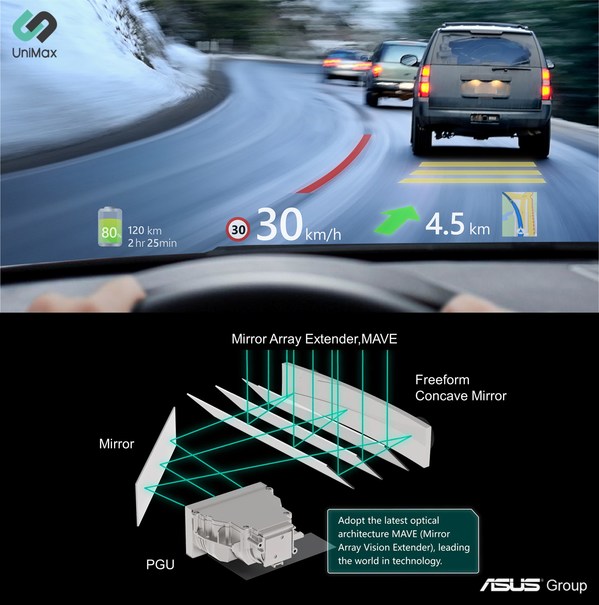All-new technology is smaller, cheaper and works with standard windshields, eliminating multiple technical and cost hurdles for automotive head-up displays
KEY POINTS
- Compact and practical: Mirror-array vision extender (MAVE) technology reduces overall volume by at least 30% for integration into smaller cars
- Ready for any windshield: High-quality projection system prevents ghosting, eradicating the need for costly wedge-glass construction
- Reduced power and heat: High-efficiency, low-power picture-generation unit (PGU) effectively minimizes the problem of heat dissipation
TAIPEI, Feb. 8, 2022 /PRNewswire/ — UniMax announced the world’s first augmented-reality head-up display (AR HUD) with mirror-array vision extender (MAVE) technology, a revolutionary new method of displaying real-time information on automobile windshields that is smaller, cheaper and more energy efficient than competitor products.
Compact and practical: Volume reduced by at least 30% for easy automotive integration
Because AR HUD needs to pass through layers of the light path and reflection design in order to achieve high-quality VID and FOV attributes, the size of AR HUD devices is also much larger than Windshield Reflection Type HUD and Combiner Type HUD.
Because of its large size, when AR HUD is installed in front of the dashboard, it will result in significant restrictions and be limited to a few car models. Medium and large-sized vehicles are easier to integrate than smaller ones. Otherwise, special designs and modifications are required for the installation area to have enough space. But if the installation area is too crowded, it will be a problem for heat dissipation.
Although most AR HUDs face technical hurdles in sizes due to their optical path design, the new generation of AR HUDs can achieve a lighter and thinner presence through improved optical path design.
Flat type AR HUD is a next-generation AR HUD that differs from the light path with multiple reflection design of the previous AR HUD products. Flat type AR HUD leverages cutting-edge MAVE technology so that the external light paths can penetrate and be reflected, such as with window blinds. Wide-format images can be projected without the need for a large panel. The size volume can be reduced by at least 30% compared with AR HUD, and it can be easily integrated into most vehicles. However, the new AR HUD technology has a high entry barrier, and few manufacturers possess this technology.
Ready for any windshield: Ghost-free image delivery removes need for wedge glass
The new UniMax AR HUD technology solves another problem for automobile manufacturers, by eliminating the need to use expensive wedge glass in the windshield.
The optical properties of traditional HUD designs mean that if the image is projected onto a standard windshield then ‘ghosting’ will occur, where a second, fainter image appears in the driver’s eye line – slightly offset from the central image. This ghost image is caused by the projection reflecting from the windshield’s second, outer glass layer.
To combat this problem, so-called wedge glass must be employed to create a slight-but-vital angle between the inner and outer layers of the windshield. Standard windshields employ a single, uniform polyvinyl butyral (PVB) bonding layer between the inner and outer glass layers. However, to prevent AR HUD ghosting, a wedge-shaped PVB layer must be created to form a precise angle between the two glass panels. This process adds significantly to manufacturing costs.
The optical technology behind the UniMax AR HUD is able to work with standard windshields, making it feasible to fit in lower-cost automobiles. This empowers vehicle manufacturers the freedom to extend the benefits of virtualized driver information to previously unreached market segments.
Reduced power and heat: Low-power picture-generation unit keeps things cooler
The UniMax AR HUD also delivers multiple ancillary benefits. It offers excellent power-to-light efficiency for both the interior and exterior light path, reducing power consumption, operating temperature and heat generation. The need to dissipate less heat also reduces the space needed for installation, as well as engineering complexity.
Compared to other AR HUD technologies, where waveguide efficiency can be as little as 1%, the UniMax product is able to realize significant savings in power consumption at the same brightness level. Specifically, the all-new MAVE technology that empowers the UniMax AR HUD is able to deliver waveguide efficiencies of up to 30% — a huge leap over competitor products.
Web: www.unimax.com.tw/en/product_detail/71
Video:https://youtu.be/xgR4FYz606A
[About UniMax]
UniMax Electronics Inc. is a professional automotive electronics design and manufacturing company, fully-owned by ASUS Group. The company leverages world-class research resources to develop high-quality, cutting-edge technology that customizes and enhances in-vehicle digital experiences for customers everywhere. By integrating ASUS Group resources and leading-edge solutions, UniMax has a goal of expanding its OE supply chain to international automobile makers while firmly establishing itself as a global pioneer of innovation in the automotive electronics and manufacturing industry.
UniMax PR Contact
Shou Yu | Marketing
shou_yu@unimax.com.tw
www.unimax.com.tw












